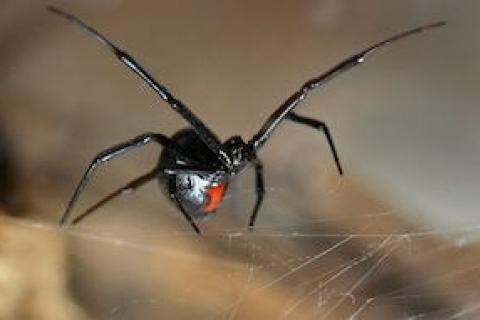
While tens of thousands of types of spiders live in the United States, only a few are considered dangerous to humans. By being able to identify these spiders and understanding how best to avoid bites, those who enjoy outdoor activities like hunting, fishing and camping can stay safe and sound.
According to information compiled from the Centers for Disease Control and Prevention, the Illinois Department of Public Health and Oregon.gov, here’s what outdoorsman need to know about venomous spiders in the U.S.:
 Black Widows
Black Widows
Where They Live: The territory of black widow spiders spans across the country, with the most common areas they inhabit being in the southern and western states. Within the areas they live, black widows tend to be found in or near sheds, garages, firewood piles, storage bins and other undisturbed places.
Appearance: Most female widows are black, with a reddish hourglass-shaped marking on the underside of their abdomens. Their bodies may measure up to a half inch long. Males are smaller, typically with grey or brown shades and red, orange or yellow markings.
Bites: Black widow spiders typically bite only when humans come into contact with their webs. Their bites create two puncture marks in the skin, from which pain spreads to other parts of the body, including the chest and abdomen. While bites rarely result in death, after-effects include pain and swelling.
It’s important to note that while the female spiders are considered quite dangerous, the males are not.
 Brown Recluse Spiders
Brown Recluse Spiders
Where They Live: Brown recluse spiders live in the Midwest and in the South. Like black widows, they’re typically found in undisturbed areas outdoors. Indoors, they’re found in dark areas such as closets and inside of shoes.
Appearance: Brown recluse spiders live up to their names – they’re both brown and reclusive. Behind their six eyes, brown recluse spiders have a violin-shaped marking.
Bites: In order to bite humans, brown recluse spiders require “counter pressure” that traps the spider against the skin, according to the CDC. When a person is bitten by a brown recluse, his or her wound generally progresses from red and swollen to a two-inch-in-diameter hardened lump within a day. In some cases, necrosis – the destroying of skin tissue – can develop.
Male brown recluse spiders cause less severe bites than females, as they have about half the venom.
 Hobo Spiders
Hobo Spiders
Where They Live: Hobo spiders are found in the Pacific Northwest. They make their homes in outdoor areas such as window wells and firewood piles. Indoors, they’re found behind furniture and in closets.
Appearance: The hobo spider is a large, brown spider with yellow markings on the abdomen. To differentiate them from similar species, note that unlike most spiders, hobo spiders will not climb; they do, however, run very quickly.
Bites: Oftentimes, the bite of a hobo spider will be unnoticeable. Sometimes, though, a slow-healing wound will develop.
Prevention
People can prevent spider bites by:
- Sealing openings into the home
- Installing window screens
- Removing spider webs from home
- Inspecting items like clothing, shoes or towels before use and storing these items in plastic bags
- Examining objects for spiders when bringing them from the outdoors into the indoors
- Using spider traps
- Vacuuming regularly
- Keeping bedding from touching floors
You’ve Been Bitten. What Do You Do?
- If possible, identify the type of spider or catch it. If you are able to retrieve it, take it along with you to where you’re seeking medical care.
- Wash the bite with soap and water.
- Elevate the affected area, and apply a cold compress.
- Seek medical attention immediately.
Stay safe!
- 4182 views

